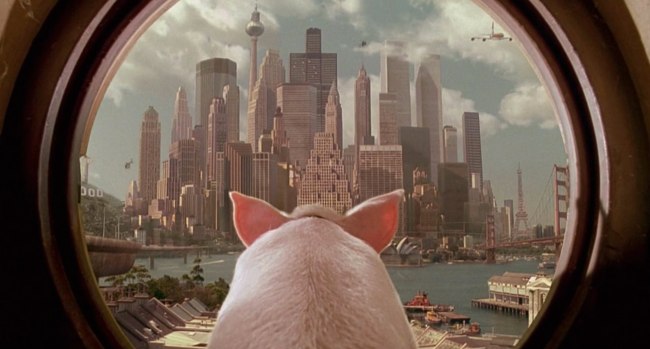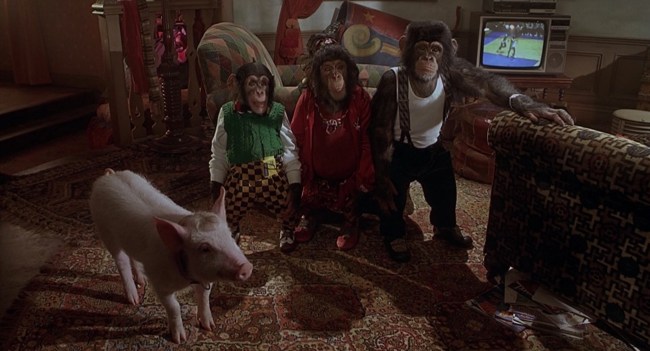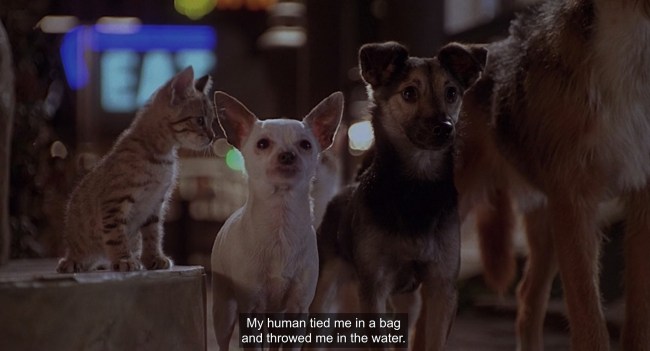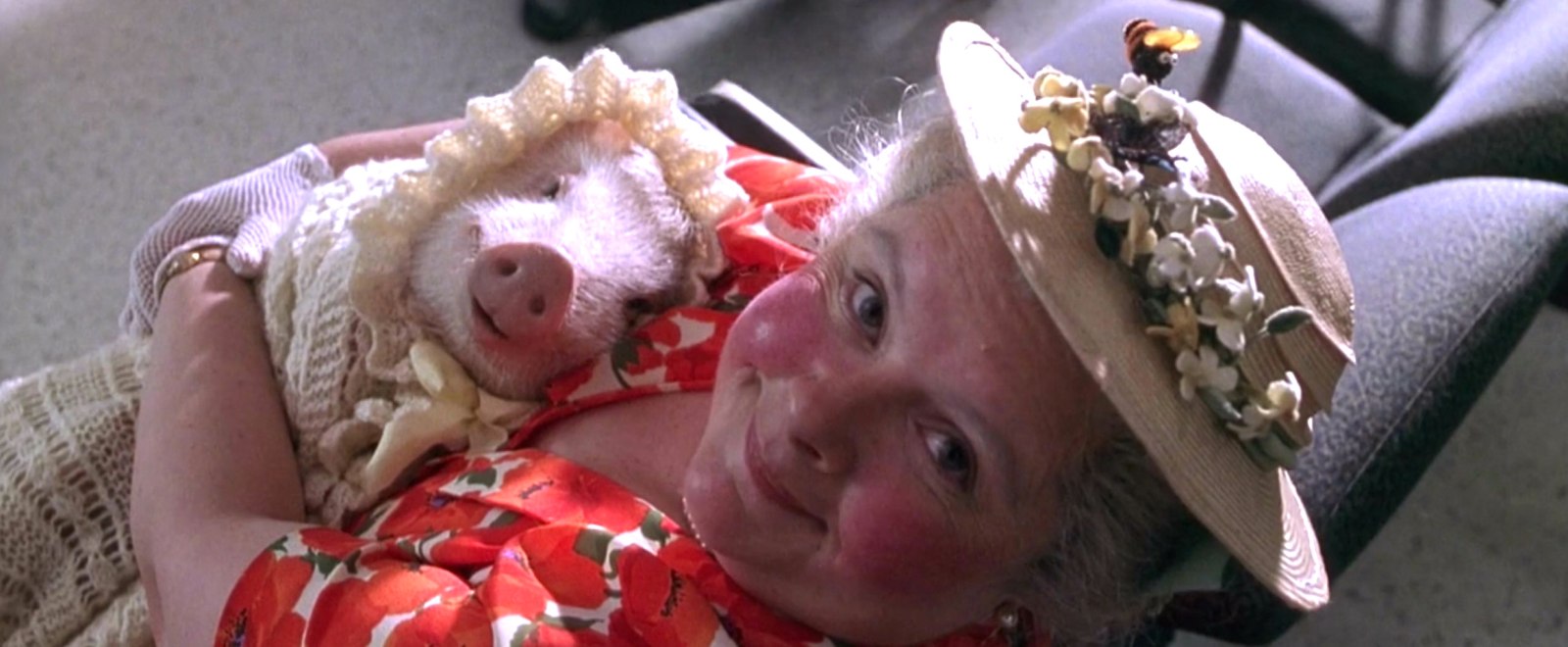Like many kids born between the late 1980s and early 1990s, I loved Babe, the spunky farm-set comedy about a talking pig that grossed $254 million at the box office and received a shocking Best Picture nomination. How many talking animals have been nominated for Best Picture? Not enough I say (A Talking Cat!?! was robbed), but at least we’ll always have Babe. The movie — about a social hierarchy-disrupting pig who believes he’s meant to herd sheep — has a famously definitive ending, with Babe proving the haters wrong and everyone’s dad Farmer Hoggett, played by Oscar nominee James Cromwell, telling him, “That’ll do, Pig. That’ll do.” I cried, you cried, we all cried. So, naturally, five minutes into the sequel, Babe accidentally almost kills Farmer Hoggett.
I should probably back up.
After Babe became a surprise hit, Universal Pictures greenlit a sequel. But rather than replicate the success of the original, Babe: Pig in the City took place not on an idyllic farm, but, well, “the city,” and director George Miller, who received a writing and producing credit for the original film, replaced Chris Noonan as director. (“I don’t want to make a lifelong enemy of George Miller, but I thought that he tried to take credit for Babe, tried to exclude me from any credit, and it made me very insecure,” Noonan said years later. Miller’s response: “When it comes to Babe, the vision was handed to Chris on a plate.”) At the time, and to this day, Miller is best known for the Mad Max movies, peaking with Fury Road, which celebrated its five-year anniversary last week. It’s not exactly kid-friendly material, but to be fair, Babe: Pig in the City isn’t a kid-friendly movie.
I don’t know who it’s for, actually. I saw it as a kid, but all I remember is being terrified and that I was confused that “the city” was actually every city at once.

The skyline includes the World Trade Center, the Sears Tower, the Chrysler Building, the Empire State Building, the IDS Center, the MetLife Building, the Sydney Opera House, the Hollywood sign, the Golden Gate Bridge, Big Ben, the Statue of Liberty, the Eiffel Tower, and the Christ the Redeemer statue, among others. It’s a Choice. This movie is full of Choices, which is why, after viewing it as an adult for the first time over weekend, I must admit: Babe: Pig in the City rules. It’s weird, it’s dark, it feels like a fever dream, it was critic Gene Siskel’s favorite movie of 1998 (over Saving Private Ryan and The Thin Red Line — Roger Ebert also had it in his top-10), Mickey Rooney plays a clown named Fugly Floom, and there’s a family of chimpanzees, all of whom wear (adorable) clothes.

But there’s one scene in Babe: Pig in the City that I keep thinking about. It’s crazier than anything in Fury Road, a masterpiece full of crazy, thrilling sequences. The scene from Babe 2 that’s on my mind isn’t thrilling, or even fun to watch, but it’s wild that it made it into a kids movie, especially the sequel to the kind-hearted Babe. First, some set up: following Babe almost killing Farmer Hoggett, his wife Esme (first-billed Magda Szubanski!) and the little pig make plans to travel to a sheepdog herding contest to pay the bills, or else the bank will evict them. But on their way, a drug-sniffing dog shows off his professional prowess to Babe, causing them to miss their connecting flight. They check into the only hotel that will have them, the Flealands Hotel, where Babe (and the mice) meets the aforementioned chimpanzees, as well as cats, dogs, and an orangutan named Thelonius, a.k.a. Thelonius Monkey. Thelonius does not care for Babe, and neither do the chimpanzees, who use the pig as a diversion to steal jellybeans. Babe, naive cutie that he is, thinks he can use his “baa-ram-ewe” trick to calm down a vicious bull terrier; instead, the dog chases him around “the city,” leaving Babe to wonder, “Something broke through the terror. Flickerings, fragments of his short life, the random events that delivered him to this, his moment of annihilation. As terror gave way to exhaustion, Babe turned to his attacker, his eyes filled with one simple question: why?”
This a G-rated kids movie. Oh yeah, and when Babe jumps off a bridge, the bull terrier follows him, except he gets stuck before fully plunging into the water, resulting in the horrifying sight of a dog dangling off a bridge while drowning. Babe saves his attacker, because he’s the Paddington of dogs, but not before George Miller shows us this:
Uh, thanks George? My father should be arrested for taking me to this movie as a kid. (I do not want to know how they filmed this scene.) Shortly after the near-drowning incident, we get this harrowing anecdote from another, much tinier dog.

Why does George Miller hate dogs? And I haven’t even mentioned the scene where a courageous Jack Russell terrier with his hind legs on wheels dies in horrific fashion, goes to dog heaven, and is cruelly returned to this hell-pit we call Earth. Poor Flealick.
Needless to say, Babe: Pig in the City was not nearly as popular as Babe — it grossed only $69 million on a $90 million budget; it also inspired an infamously terrible video game and was nominated for an Oscar (Best Original Song), but lost to “When You Believe” from The Prince of Egypt. But I, and many others who have reevaluated the film in recent years, can now appreciate Miller’s f*cked-up vision of how the big city is full of cruel people who will chew you up (literally, if you’re a pig), if you let them. In that sense, the Babe sequel isn’t so different than Fury Road, with the Citadel as “The City.” Except Fury Road has a blind mutant playing a double-necked, flame-throwing guitar. Babe: Pig in the City has a dog almost drowning. The Doof Warrior makes sense to me, though — he’s in a dystopic R-rated action movie from the same guy who set a movie in a Thunderdome and created characters named the Lord Humungus and Master Blaster. Nothing about the unexpectedly nightmarish Babe: Pig in the City makes sense, especially at that point in Miller’s career, before he made the dancing penguin movies.
It’s the wildest film in a wild filmography. That’ll do, George. That’ll do.







